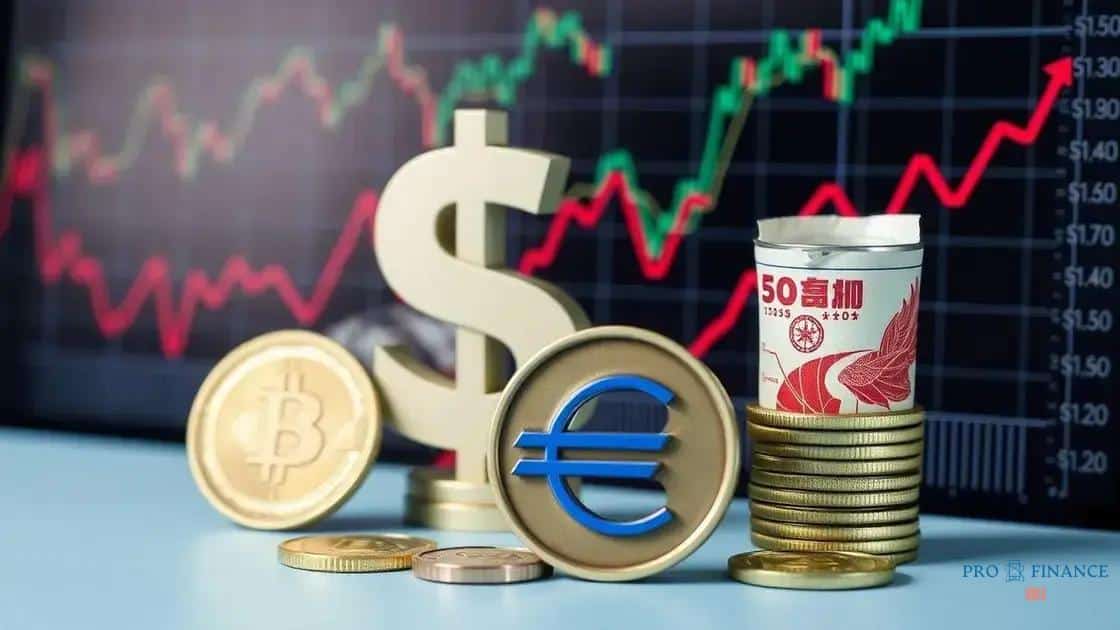How interest rate changes affect global financial markets

Interest rate changes directly affect global financial markets by influencing stock prices, currency values, and trade balances, making them crucial for investors to monitor for informed decision-making.
Have you ever wondered how interest rate changes affect global financial markets? These shifts can create ripples across economies, influencing everything from investment strategies to daily consumer behavior. Let’s dive into the intricate connections and what they mean for you.
Understanding interest rates and their role in economies
Understanding interest rates is essential for grasping how economies function. These rates influence consumer spending, business investments, and overall economic growth. When interest rates rise, borrowing becomes more expensive, which can slow down spending. Conversely, lower interest rates encourage borrowing, stimulating the economy.
The Role of Interest Rates
Interest rates are set by central banks and play a crucial role in economic policy. They help control inflation and stabilize the currency. By adjusting rates, central banks can influence economic activity, affecting everything from home loans to corporate financing.
Key Impacts of Interest Rate Changes
- Consumer behavior changes with fluctuations in borrowing costs.
- Investment patterns shift as businesses assess the cost of capital.
- Exchange rates are affected as interest rates differ between countries.
When rates increase, consumers may hold off on buying big-ticket items like homes or cars, while businesses might delay expansion plans. This cautious approach can lead to slower economic growth. On the other hand, when interest rates are lowered, spending typically increases, leading to a more robust economic environment.
Interest Rates and Inflation
Inflation is another critical factor in the interest rate relationship. When inflation rises, central banks often raise interest rates to cool the economy. This action can lead to higher borrowing costs, slowing the economy further.
Understanding how interest rates interact with inflation helps investors make informed decisions. It’s vital to stay updated on these dynamics, as they impact everything from personal finances to global markets.
Immediate impacts of interest rate changes on stocks

The immediate impacts of interest rate changes on stocks can be significant and quick. When central banks announce rate hikes, stock prices often react negatively. Investors worry that higher borrowing costs will reduce corporate profits. On the contrary, if rates are cut, the market usually responds positively, anticipating increased spending and investment.
Market Sentiment and Stock Prices
Investor sentiment plays a crucial role in how stocks react to interest rate changes. Market confidence can shift rapidly. A rate increase might suggest that the economy is overheating, prompting investors to sell stocks. Conversely, lower rates can boost enthusiasm, encouraging investors to buy.
- Higher rates can lead to decreased consumer spending.
- Lower borrowing costs may stimulate business investments.
- Stock sectors respond differently based on their sensitivity to interest rates.
Companies that rely heavily on debt may experience more significant stock price declines when rates rise. This is because their interest expenses increase, impacting profit margins. Meanwhile, sectors like utilities may become less attractive as borrowing costs rise, while technology companies often thrive in lower interest rate environments.
The Influence of Rate Changes on Growth Stocks
Growth stocks are particularly sensitive to interest rate changes. When rates go up, future cash flows from these companies are discounted at a higher rate, making them less appealing to investors. As a result, stock valuations may drop.
In the face of rising rates, some investors may shift their focus to more stable, dividend-paying stocks. These stocks often provide a reliable income source that can buffer against market volatility during periods of high interest rates.
How bond markets react to interest rate fluctuations
Understanding how bond markets react to interest rate fluctuations is essential for investors. When interest rates rise, bond prices typically fall. This inverse relationship means that existing bonds with lower rates become less attractive, leading to a decrease in their market value. Conversely, when interest rates drop, bond prices generally increase, making fixed-rate bonds more appealing to new investors.
Impact on Different Types of Bonds
Different bond types react uniquely to interest rate changes. For instance, corporate bonds may suffer more if interest rates rise, as companies may face higher funding costs. Government bonds, considered safer investments, often react differently, attracting investors seeking stability in volatile markets.
- Government bonds usually offer lower yields but are less sensitive to rate changes.
- Corporate bonds may offer higher yields, compensating for higher risk levels.
- Long-term bonds are more affected by rate hikes than short-term bonds.
Alternatively, short-term bonds tend to have less price sensitivity to interest rate changes. As investors anticipate future rate hikes, they may prefer shorter durations to limit exposure to potential price drops. This strategy helps mitigate risks associated with rate fluctuations.
The Yield Curve’s Role
The bond market’s reaction is often illustrated through the yield curve. A normal yield curve slopes upward, indicating higher yields for longer-term bonds. When rates rise, the curve may flatten or even invert, suggesting that investors expect weaker economic growth.
Understanding the yield curve is crucial for grasping market expectations regarding interest rates. An inverted yield curve, for example, can signal a potential recession, causing investors to adjust their strategies accordingly.
Interest rates and their influence on currency values

The relationship between interest rates and currency values is complex yet crucial. When a country’s central bank raises interest rates, its currency typically strengthens. Higher rates offer better returns on investments in that currency, attracting foreign capital. This demand boosts the currency’s value.
Immediate Effects on Currency Markets
After an interest rate hike, forex markets react quickly. Traders adjust their positions based on expected returns. A stronger currency can lead to cheaper imports and more expensive exports, impacting the trade balance.
- Stronger currencies make imports cheaper for consumers.
- Exporters may suffer as their goods become pricier abroad.
- Businesses adjust pricing strategies in response to currency fluctuations.
When rates decrease, the opposite occurs. A lower interest rate can weaken a currency as capital flows out in search of better yields elsewhere. As a result, import costs may rise, leading to inflation concerns.
Influence on Inflation and Economic Stability
Interest rates influence not only currency values but also inflation. A stronger currency can help keep inflation in check. However, a weaker currency might raise prices, affecting consumer behavior.
Investors often look at interest rates when assessing currency risks. For example, during periods of economic uncertainty, investors might favor currencies backed by higher interest rates, seeking security in more stable economies. This behavior reinforces the currency’s strength.
Long-term effects of interest rate policies on global trade
The long-term effects of interest rate policies on global trade can shape the economic landscape significantly. As central banks adjust interest rates, these changes ripple through economies worldwide, influencing trade balances, currency values, and investment flows.
Interest Rates and Trade Balances
Higher interest rates in a country may strengthen its currency. A stronger currency can make exports more expensive and imports cheaper, affecting the trade balance. Countries that rely heavily on exports may face challenges as their goods become pricier on the international market.
- Strong currencies can hurt exporters, leading to reduced sales overseas.
- Imports become cheaper, increasing competition for local products.
- Trade deficits may widen if exports decline significantly.
Conversely, when interest rates are low, the local currency might weaken. This situation can boost exports, as goods become more competitively priced for foreign buyers. As nations export more, it can lead to a favorable trade balance, enhancing economic growth.
Foreign Investment and Trade Dynamics
Interest rate policies also affect foreign direct investment (FDI). Countries with lower interest rates may attract more foreign investment, leading to increased production capacity and export potential. Investors seek to capitalize on cheaper borrowing costs, fueling growth.
On the other hand, if rates are too low for prolonged periods, it might lead to inflationary pressures. This situation can destabilize economies and impact trade dynamics and investment decisions. Investors need to evaluate interest rate trends when considering long-term commitments in foreign markets.
FAQ – Common Questions About Interest Rate Changes and Financial Markets
How do interest rate changes affect stock prices?
Interest rate hikes typically lead to lower stock prices, while cuts can boost them, as investors react to changes in economic conditions.
What is the impact of interest rates on currency values?
Higher interest rates usually strengthen a currency, making exports more expensive, whereas lower rates can weaken a currency and boost exports.
How do interest rate policies influence global trade?
Interest rate policies can affect trade balances by altering currency values, which impacts import and export prices and overall economic competitiveness.
Why is it important to monitor interest rate trends?
Monitoring interest rate trends helps investors make informed decisions about investments, as these rates signal shifts in economic stability and growth.






